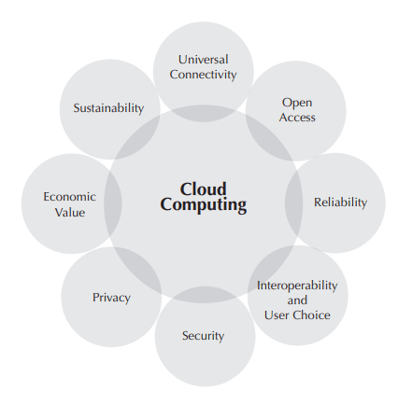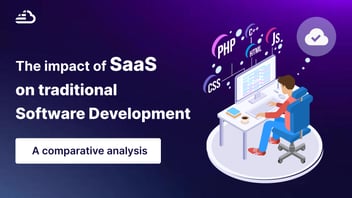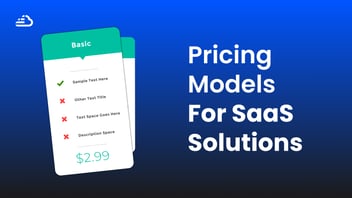How SaaS Vs Traditional Software Make the Startups Thrive
Technology is always improving and evolving at a pace with the fast world. In the age of cloud computing, SaaS (Software as a Service) has been the standard. The advantages of the SaaS model much outweigh the negatives. The reason for this popularity is due to the obvious and undeniable SaaS advantages.
Today, there are a plethora of SaaS businesses. In 2019, the SaaS market area was estimated to have around 7000 SaaS companies. In 2021, the SaaS development business has experienced rapid growth, with a predicted increase of 80% by the end of the year.
Is this form of outsourced technology right for your business? Let's find it out.
What SaaS is?
Software as a service (SaaS) is a cloud based software distribution model in which applications are licensed on a subscription basis and are delivered over the Internet. A SaaS development company stores all of its products in the cloud and sells them to customers over the internet.
Some of the best cloud services that operate on the SaaS model are Google Apps, Office 365, Salesforce, Slack, Concur, Canva, Amazon web services, and Workday.
Undaku is a powerful no code application development platform that will give a fully functional, turnkey SaaS, allowing developers and their customers to enjoy minimal friction and flawless user experience while leveraging an efficient platform with the most innovative technological resources.
What is Traditional Software (on-premise)?
Traditional software has been sold in retail stores for decades. It's also known as shrink-wrapped software or packaged software, and it is the sort of software you buy off the shelf at your local computer store and take home with you.
In the past, businesses were built on a one-to-many relationship. In other words, a company would create products and services for its customers who would buy. The new business paradigm is based on many-to-many relationships. This means that companies need to make their customers feel like an active part of their business ecosystem by engaging with them and giving them a voice.
Traditional software is installed and runs on a computer, making it desktop dependent. They are connected via a remote server. This server gives access to business stored data and applications to all employees that use the hardware.
Every business requires a safe and secure storage location where data and applications can be accessed quickly and operating costs are kept to a minimum. The SaaS development model offers various advantages for both startups and existing businesses.
Benefits of SaaS over Traditional Software
Traditional software is being driven out in favor of the software-as-a-service approach. Let's go through the following key benefits of SaaS over traditional software:

-
Accessibility
SaaS development provides out-of-the-box functionality. Because SaaS is delivered through the cloud, users can easily access their software solutions from any place around the world because each person has their own unique login. You can access your SaaS applications through any device like laptops, mobile phones, tablets, etc. This makes work easier and more convenient.
However, on-premise software must be installed on the user's computer.
- Deployment
Adopting a cloud-based solution allows you to start immediately and doesn't have to go through a lengthy deployment procedure.
While traditional software needs to be installed for it to work, needs the right hardware, right configuration, and ultimately you need someone with IT skills to manage it all. Therefore, it takes several months to get an on-premise application up and running.
- Time to scale
When a business uses SaaS, you don't have to worry about hardware resources or maintenance. Cloud based implementation minimizes the overall implementation time of projects, allowing the SaaS business to gain value sooner.
In traditional software, long-term resource planning is required in order to scale the application with the company's growth. There are a lot of moving parts that you need to deal with running your business smoothly, and it takes time.
- Pricing
SaaS allows you to pay only for what you use and has access to all the tools you need for your business. As long as the client is prepared to pay more monthly fees, SaaS businesses have the scale to fulfill the additional requirements quickly.
Because many SaaS providers (Undaku) offer free trials, you can test the SaaS software and decide if it works for your startup or company without spending any money.
In traditional software, a one-time payment is needed in which the buyer pays the amount beforehand.
- Upgradation
Since cloud based, SaaS startups and SaaS companies eliminate the need to purchase physical server space. Updates are distributed routinely and without charge by SaaS companies. This allows you to make updates at any time.
Traditional software can be quite expensive. It demands the purchase of a specific software license for each user. You have to wait for the new version of the updates to be released with new features before you get them. To adapt to business expansion, you will need to buy new equipment and server space. The value of the server depreciates year after year, resulting in a low return on investment.
- Upfront and maintenance cost
In SaaS, no need to buy any extra hardware, and hence no equipment is required to maintain. This eliminates the upfront costs. Also, making it easy for customers without having to worry about IT support costs. Multi-tenancy keeps the cost down, allowing SaaS startups and businesses to develop new SaaS apps for a large number of people while sharing the same infrastructure. Onboarding a new client is normally free of charge, and there are no hidden fees. As a result, the SaaS development and maintenance costs are reduced.
In traditional software, customers had to spend a huge amount of money to purchase hardware resources. Each person has to be given a computer with the software installation and ongoing expenditures like maintenance and upgrade. All are time-consuming as well as expensive too.
- Flexibility
The SaaS applications that are hosted in the cloud are dispersed among all the servers. As a result, if one server fails, no data is lost, and no downtime occurs. The cloud provides extra storage space, server resources, and increased computational power. SaaS provides greater flexibility.
Traditional software is less flexible and cannot guarantee a high level of performance consistently. You have to purchase a license for every employee in your organization. They have limited capacity and are prone to downtime. This can significantly reduce work productivity.
- Integration
The simplicity with which any given SaaS solution integrates with all of the organization's other applications should be an important issue. Many SaaS applications include integration tools. Google suite, HubSpot are great examples of SaaS integration.
Traditional software is chosen by firms who are concerned about their privacy because there is no third party involved.
- Learning curves
SaaS tools are simple to use and therefore easy to learn. To get most of such technologies, you don't need to be an IT expert. Previously inaccessible enterprise apps can now be readily deployed because users do not need to download complicated software.
Traditional software has a low learning curve. You require experts to get trained to the employees to get comfortable with your software. You have to invest a lot of time and effort at an additional cost.
- Cross-platform
SaaS applications can be accessed from nearly any device via a web browser, resulting in better cross-platform compatibility. Users may now access information from anywhere, including on their mobile devices, increasing productivity and efficiency.
But in on-premise software, applications have to be made for specific devices, and employees have to be specialized.
- Secure
SaaS apps are safe as all the data is in the cloud. If one data center has a disaster, the other data centers continue to operate and provide services.
While in traditional software, all data remains inside the company it can suffer downtime if no backup is provided.
All these advantages drive the investors bullish about the SaaS businesses. The significant cost savings of a SaaS system are derived from not having to maintain your own IT infrastructure for hosting, data security, and hardware maintenance which lowers the total cost of ownership (TCO).
To know more, check out these resources:
SaaS in 2021: How prodigious growth changed the startup landscape permanently
Why your next startup should be SaaS and how to build one?
SaaS success stories to inspire your growth strategy
Conclusion
Every successful business needs a scalable infrastructure capable of supporting any-to-any hybrid integration, data transformation, rapid and secure file transfer, and end-to-end visibility of all data flowing through their complex ecosystems.
The multi-tenant architecture clearly plays a critical and complete role in the development of SaaS applications. It. The difficulties could include issues with data confidentiality and security, as well as efforts to load the development.
Undaku has extensive experience in digital and web marketing, has allowed us to design, develop and integrate powerful creative platforms with innovative customer and developer engagement solutions. This SaaS development platform makes it simple for startups to kick start their SaaS app development process and reach out to the client as quickly as possible.
Contact Undaku to know more about how they can help your SaaS startup or business scale quickly.


